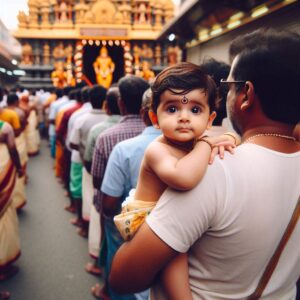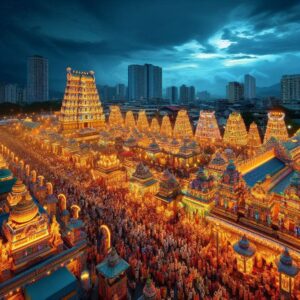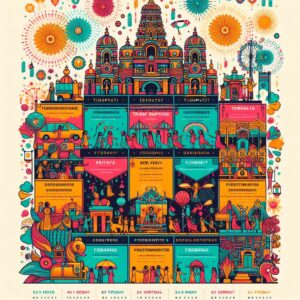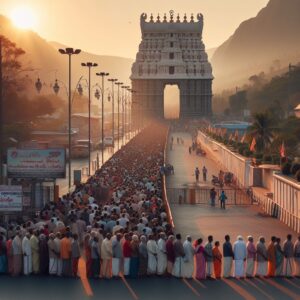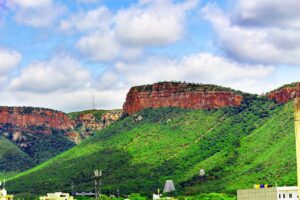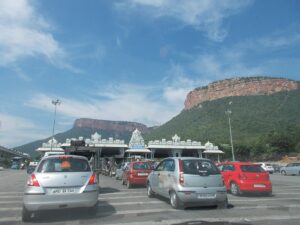Tirupati Balaji, also known as Lord Venkateshwara, is a deity who holds a special place in the hearts of countless devotees. His story is a fascinating blend of myth, legend, and unwavering devotion. Let’s dive into the enchanting history of this beloved Lord, whose temple is often referred to as Kaliyuga Vaikuntam.
The Sacred Abode:
The temple town of Tirupati is nestled at the foothills of Tirumala in Andhra Pradesh. At an elevation of approximately 2,800 feet above sea level, Tirumala is the divine abode of Lord Venkateshwara. The seven hills of Tirupati are often equated with the seven heads of Adisesha, the serpent on which Lord Vishnu rests.
Revealing the Myth:
According to Hindu scriptures, Lord Vishnu incarnated as Venkateshwara out of boundless love for His devotees. In this form, He came to Earth to offer salvation and uplift humanity in the current age known as Kali Yuga. Venkateshwara is considered the supreme form of Lord Vishnu in this era.
The Iconic Temple:
The primary temple dedicated to Lord Venkateshwara is in Tirupati and is a must-visit for many devotees, especially among the GSB community in Kerala. Lord Venkateshwara, with His dark complexion and four hands, holds a discus symbolizing power, and a conch shell symbolizing existence. His lower hands extend outward, inviting devotees to have faith and surrender for protection.
The Origin Story:
The legend of Lord Venkateshwara’s incarnation is nothing short of intriguing. It all began with a group of sages led by Kasyapa who were performing a sacrifice on the banks of the Ganges. When Sage Narada questioned the purpose of the sacrifice, the sages were left perplexed. Seeking an answer, they turned to Sage Bhrigu, who went on a quest to find the most worthy deity.
Bhrigu first visited Lord Brahma in Satyaloka, but Brahma remained absorbed in his devotion to Lord Narayana. Bhrigu then journeyed to Kailasa, the abode of Lord Shiva, but Shiva was preoccupied with his consort Parvati. When Bhrigu intruded, Shiva’s fury was ignited, and he attempted to destroy the sage.
The Divine Test:
Disheartened by his encounters with Brahma and Shiva, Bhrigu arrived in Vaikuntam, the abode of Lord Vishnu. There, he found Vishnu reposing on Adisesha with Goddess Mahalakshmi at His feet. When Vishnu did not immediately acknowledge Bhrigu, the sage kicked the Lord on His chest, where Mahalakshmi resides.
In response, Lord Vishnu, full of compassion, rushed to apologize and eased Bhrigu’s pain by pressing his feet. However, this act resulted in the removal of the eye in Bhrigu’s foot, along with his special powers. Convinced of Lord Vishnu’s supremacy, Bhrigu declared his findings to the other sages.
The anger of Mahalakshmi:
Mahalakshmi, angered by Lord Vishnu’s apology to Bhrigu, left Vaikuntam and resided in Karavirapur, which is now known as Kolhapur. In her absence, Lord Vishnu, in the form of Venkateshwara, sought penance on Venkata Hill, near a tamarind tree and an ant hill, without food or sleep.
Intercession of God:
Compassionate beings such as Lord Brahma and Lord Shiva, in the forms of a cow and calf, started serving Venkateshwara to alleviate His suffering. Surya, the Sun God, informed Mahalakshmi about this and urged her to take the form of a cowherd to serve the king of the Chola country.
The Divine Union:
King Akasa Raja, who ruled Thondamandalam, had no heirs and desired to perform a grand sacrifice. During the plowing of the fields for this ritual, a lotus emerged, cradling a female child. King Akasa Raja adopted her, named her Padmavati, and raised her as his own.
The Tale of Vedavati:
In her previous life, Padmavati was Vedavati, who had cursed Ravana, the demon king of Lanka. To prove the truth of her curse, Vedavati entered the fire, but Agni, the Fire God, saved her. Ravana was misled into thinking Vedavati was the honest Sita and abducted her. It was only after Ravana’s downfall that Vedavati sacrificed herself in the fire.
The Fateful Encounter:
One day, while hunting, Lord Srinivasa (Venkateshwara’s form) was led into a garden by a wild elephant. There, he encountered Princess Padmavati and her maidens. The elephant’s presence initially frightened the princess and her companions, but it suddenly saluted the Lord and vanished into the forest.
Love Blossoms:
Lord Srinivasa was captivated by Padmavati’s beauty, but when he approached her, the maidens repelled Him by throwing stones. He returned to the hills, leaving his horse behind. Distraught, he revealed to Vakuladevi, his caretaker, that he could not find happiness unless he married Padmavati.
The Divine Union:
Vakuladevi realized the depth of Srinivasa’s love and decided to facilitate the marriage. As she made her way to Akasa Raja’s palace, she learned that Padmavati also yearned for Srinivasa. Akasa Raja, upon consulting with sage Brihaspati, decided that the marriage would be beneficial for both parties. Kubera, the Lord of Wealth, lent the necessary funds for the wedding.
The Grand Marriage:
Srinivasa, accompanied by his consorts and Lord Brahma and Lord Shiva, began on a journey to Akasa Raja’s palace. Upon arrival, he was welcomed with great honor and taken in a procession to the court. In the presence of the Devas, Srinivasa, and Padmavati were united in marriage, thereby bestowing blessings on Akasa Raja.
Conclusion
This history of Lord Tirupati Balaji, with its rich tapestry of myth, legend, and devotion, continues to inspire millions of devotees worldwide. The divine love story of Srinivasa and Padmavati exemplifies the enduring power of faith and the ultimate union of two souls destined to be together for eternity. Lord Venkateshwara’s divine abode in Tirupati remains a beacon of hope and spirituality for all who seek His blessings.
In this journey of devotion, Viswambara Travels is your trusted partner, offering pilgrims the opportunity to undertake a spiritual quest to the sacred abode of Lord Venkateshwara in Tirupati. Our services are designed to provide a seamless and meaningful travel experience, allowing devotees to connect with their faith and explore the captivating history of Lord Tirupati Balaji in person.
FAQ
1. What is the significance of Lord Venkateshwara’s incarnation in Kali Yuga?
Lord Venkateshwara is believed to have incarnated in Kali Yuga to offer salvation and upliftment to humanity. He is considered the supreme form of Lord Vishnu in this age.
2. Can you explain the legend of Lord Venkateshwara’s incarnation briefly?
Lord Venkateshwara’s incarnation began with a sage named Bhrigu, who sought to find the most worthy deity among the Holy Trinity. His encounters with Lord Brahma, Lord Shiva, and Lord Vishnu led to a revelation of Lord Vishnu’s supreme nature.
3. Why did Goddess Mahalakshmi leave Vaikuntam, and what happened afterward?
Goddess Mahalakshmi left Vaikuntam out of anger due to Lord Vishnu’s apology to Sage Bhrigu. In her absence, Lord Vishnu assumed the form of Venkateshwara and sought penance. The divine intervention of Lord Brahma and Lord Shiva as a cow and calf played a crucial role in this tale.
4. Who is Princess Padmavati, and how is she connected to Lord Venkateshwara?
Princess Padmavati is the reincarnation of Vedavati, who had cursed Ravana in her previous life. Lord Rama promised to marry her at her next birth, and this promise led to her union with Lord Venkateshwara.
5. What led to the marriage of Lord Srinivasa (Venkateshwara) and Padmavati?
The divine love story unfolded when Lord Srinivasa encountered Princess Padmavati in a garden. Their mutual affection, along with the blessings of the Devas, culminated in a grand marriage ceremony.
6. What is the moral or spiritual lesson one can draw from this history?
The history of Lord Tirupati Balaji is a testament to the power of faith, devotion, and the fulfillment of divine promises. It underscores the idea that love and devotion can lead to the union of souls.

